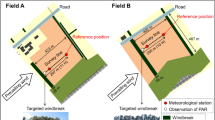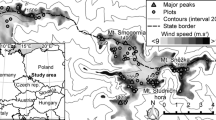Abstract
A model was developed to simulate the effects of competition for soil water and radiation between windbreaks and pearl millet crops in the Sahel. These effects on millet (Pennisetum glaucum (L.) R. Br.) growth were simultaneously simulated for each millet row parallel to the windbreak with small time steps for soil water processes, radiation availability and crop assimilation. The crop routine of the model was based on an existing semi-deterministic model. The soil-water flow was simulated in two dimensions to account for horizontal gradients. Competition for water was expressed by distributing the available soil water between trees and millet in proportion to its uptake rates in a non-competitive situation. Competition for light was incorporated as light reduction through a two-dimensional (windbreak) barrier with time-increasing height and density. Tree parameters were introduced as fixed values or as time-dependent forcing functions. Crop, windbreak trees (Bauhinia rufescens Lam.), and soil data inputs were either field-determined or obtained from literature. Reasonable agreement between simulated and measured soil water content and dry matter production was obtained under the conditions in Niger. Global radiation intensities and soil water contents were simulated satisfactorily as a function of time and the distance from the windbreak. Hence, the model is appropriate to analyse competition for light and water between windbreaks and crops.
Similar content being viewed by others
References
Bley J (1990) Experimentelle und modellanalytische Untersuchungen zum Wasser-und Nährstoffhaushalt von Perlhirse (Pennisetum americanum L.) im Südwest-Niger. PhD Thesis, University of Hohenheim, Stuttgart, Germany, 132 pp
Breman H and Kessler JJ (1995) Woody plants in agro-ecosytems of semi-arid regions. Advanced Series in Agricultural Sciences 23. Springer-Verlag, Berlin Heidelberg, Germany, 340 pp
Brenner AJ, Beldt, RJ van den and Jarvis PG (1993) Tree-crop interface competition in a semi-arid Sahelian Windbreak. Paper presented at the 4th International Symposium on Windbreaks and Agroforestry, 26–30 July, Viborg, Denmark: 15–23
Brenner AJ, Jarvis PG and Beldt RJ van den (1995) Windbreak-crop interactions in the Sahel. 2. Growth response of millet in shelter. Agric For Meteorol 75: 235–262
Campbell GS (1974) A simple method for determining unsaturated conductivity from moisture retention data. Soil Sci 117(6): 311–314
Conijn JG (1995) RECAFS: a model for resource competition and cycling in agroforestry systems. Model description and user manual. Production Soudano-Sahelienne (PSS). Rapports PSS No. 12, Research Institute for Agrobiological and Soil Fertility, Wageningen, the Netherlands, 102 pp
Durar AA and Skidmore LE (1995) Hydrology Submodel. In: Hagen LJ et al. (eds) Wind Erosion Prediction system (WEPS). User Manual, pp H1–H64. Technical Documentation, Kansas State University, Manhattan, USA
FAO (1984) Guidelines for predicting crop water requirements. Vol 1. Irrigation and drainage paper, No. 24. FAO, Rome, Italy
Fechter J (1993) The simulation of pearl millet (Pennisetum GlaucumL.) growth under the environmental conditions of South-west Niger, West Africa. PhD Thesis, University of Hohenheim, Stuttgart, Germany, 121 pp
Feddes RA and Koopmans RWR (1995) Agrohydrology. Lecture Notes No. 06141109, Wageningen University, Wageningen, the Netherlands
Genuchten MTh van (1987) A numerical model for water and solute movement in and below the root zone. Reserach Report 121, USDA, Agricultural Service, US Salinity Laboratory, Riverside, California, USA
Hagen L (1991) A wind erosion prediction system to meet user needs. J Soil Water Conserv 46(2): 106–111
Heinen M and de Willigen P (1992) FUSSIM2. A simulation model for two-dimensional flow of water in unsaturated soil. No. 260, Research Institute for Agrobiological and Soil Fertility, Haren, the Netherlands, 146 pp
Heinen M (1997) Dynamics of water and nutrients in closed, recirculating cropping systems in glasshouse horticulture. With special attention to lettuce grown in irrigated sand beds. PhD Thesis, Agricultural University of Wageningen, the Netherlands, 270 pp
Heemst HDJ (1988) Plant data values required for simple crop growth simulation models: review and bibliography. Simulation Report CABO-TT No. 17. Department of Theoretical Production Ecology, Agricultural University Wageningen, the Netherlands, 100 pp
Keulen H van and Seligman NG (1987) Simulation of water use, nitrogen nutrition and growth of a spring wheat crop. Simulation Monographs, Pudoc Wageningen, the Netherlands, 310pp
Kessler JJ (1992) The influence of karité (Vitellaria paradoxa) and néré (Parkia biglobosa) trees on sorghum production in Burkina Faso. Agrofor Syst 17: 97–118
Long SP and Persaud N (1988) Influence of neem (Azardirachta indica) windbreaks on millet yield, microclimate, and water use in Niger, West Africa. In: Unger PW, Sneed TV, Jordan W and Jensen R (eds) Challenges In Dryland Agriculture–A Global Perspective, pp 313–314. Texas Agricultural Experimental Station, Texas, USA
Mayus M, Allison BE and Sivakumar MVK (1996) Windbreak effects on millet growth in the Sudano-Sahelian Zone. In: Buerkert B, Allison BE and Oppen M von (eds) Wind erosion in West Africa: The problem and its control, pp 99–114. Proceeding of an International Symposium on Wind Erosion, 5–7 December 1994, Markgraf Verlag, Weikersheim, Germany
Mayus M (1998) Millet growth in windbreak shielded fields. PhD Thesis, Wageningen Agricultural University, Wageningen, the Netherlands, to be published
McNaughton KG, pers. comm. (1992) Plant Physiology Division, Dept of Scientific and Industrial Research, (DSIR) Palmerston North, New Zealand
Ong CK (1996) A framework for quantifying the various effects of tree-crop interactions In: Ong CK and Huxley P (eds) Tree-crop interactions. A physiological approach, pp 1–23. CAB CAB International, Wallingford, UK
Ong CK and Monteith JL (1985) Response of pearl millet to light and temperature. Field Crop Res 11: 141–160
Onyewotu LOZ, Ogigirigi MA and Stigter CJ (1994) A study of competitive effects between Eucalyptus camaldulensisshelterbelt and adjacent millet (Pennisetum typhoides) crop. Agric Ecosys Environ 51: 281–286
Penman HL (1948) Natural evaporation from open water, bare soil, and grass. Proc R Soc London Series A, 193: 120–146
Penning de Vries FWT and Laar van HH (eds) (1982) Simulation of plant growth and crop production. Simulation Monographs, Pudoc, Wageningen, the Netherlands, 320 pp
Press HW, Flannery BP, Teukolsky SA and Vetterling WT (1990) Numerical recipes in C. The art of scientific computing. Cambridge University Press, USA, 735 pp
Sivakumar MVK, Maidoukia A and Stern RD (1993) Agroclimatology of West Africa: Niger, 2nd edition. ICRISAT Information Bulletin No. 5. International Crops Research Institute for the Semi-Arid Tropics, Patancheru, A.P., India, 108 pp
Spitters CJT, Toussiant HAM and Goudriaan J (1986) Separating the diffuse and direct component of global radiation and its implications for modeling canopy photosynthesis. Part I. Components of incoming radiation. Agric For Meteorol 38: 217–229
Soumaré A, Groot JJR, Koné D and Radersma S (1994) Structure spatial du système racinaire de deux arbres du Sahel: Acacia seyalet Sclerocarya birrea. Rapports PSS No. 5. AB-DLO, Wageningen, the Netherlands, 36 pp
Stroosnijder L (1982) Simulation of soil water balance. In: Penning de Vries FWT and Laar HH van (eds) Simulation of plant growth and crop production, pp 175–193. Simulation Monographs, Pudoc, Wageningen, the Netherlands
Verberne E, Dijksterhuis G, Jongschaap R, Bazi H, Sanou A and Bonzi M (1995) Simulation des cultures pluviales au Burkina Faso (CP-BKF3): sorgho, mil et mais. Research Institute for Agrobiological and Soil Fertility, Wageningen, Netherlands, Bureau National des Sols INERA and Intstitut d’Etudes et de Recherches Agricoles, Burkina Faso, No. 18: 53 pp
West LT, Wilding LP, Landeck JK and Calhoun FG (1984) Soil survey of the ICRISAT International Sahelian Center, Niger, West Africa. Bulletin of Soil and Crop Science Department/TropSoils, Texas A&M University, USA, 65 pp
Author information
Authors and Affiliations
Rights and permissions
About this article
Cite this article
Mayus, M., Van Keulen, H. & Stroosnijder, L. A model of tree-crop competition for windbreak systems in the Sahel: description and evaluation. Agroforestry Systems 43, 183–201 (1998). https://doi.org/10.1023/A:1026444414803
Issue Date:
DOI: https://doi.org/10.1023/A:1026444414803




